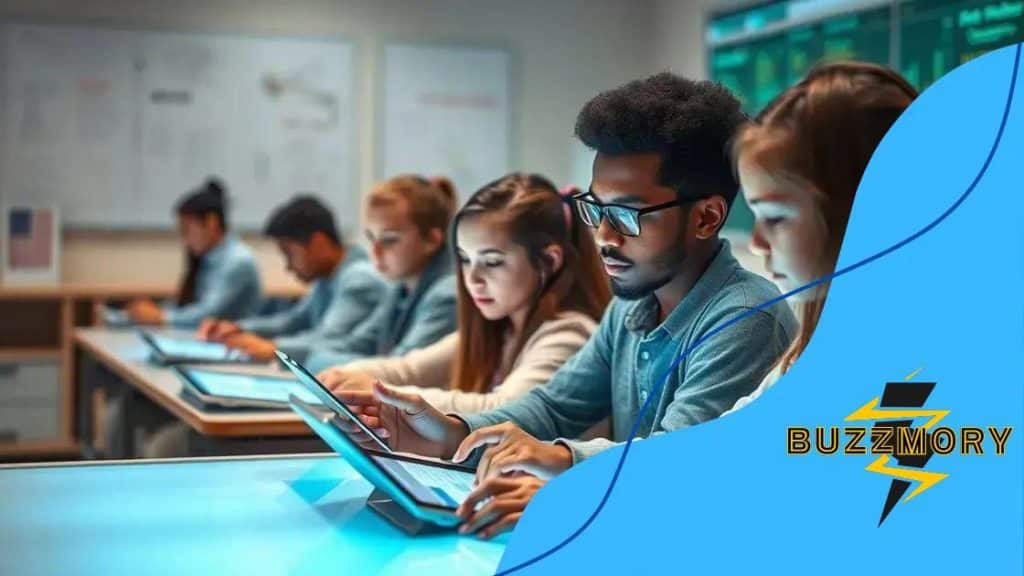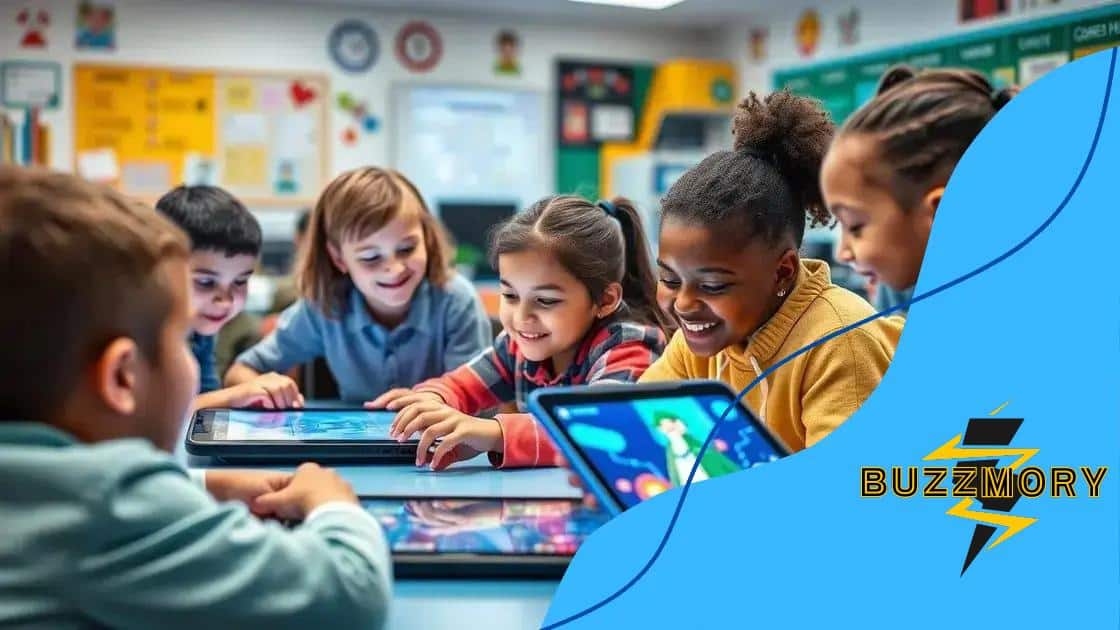How AI-driven education tools are improving student success

AI-driven education tools are improving student success by providing personalized learning experiences, enhancing engagement, and transforming assessment methods while addressing challenges such as cost, teacher training, and data privacy.
How AI-driven education tools are improving student success is a fascinating exploration of modern learning dynamics. With technology reshaping educational landscapes, it’s worth examining how these tools enhance engagement, accessibility, and tailored learning experiences for every student.
Understanding AI-driven education tools
Understanding AI-driven education tools is essential in today’s learning environment. These tools leverage technology to personalize education and enhance student engagement. By integrating artificial intelligence, they effectively respond to individual learning needs.
What are AI-driven education tools?
AI-driven education tools encompass a range of technologies that use machine learning algorithms to refine educational processes. They can adapt to each student’s pace and learning style, making them invaluable in any classroom setting.
Key features of AI education tools
- Personalization: AI tools tailor learning plans based on student performance.
- Immediate feedback: Students receive prompt responses to their work, aiding in quick understanding.
- Data analysis: These tools provide insights into student engagement and achievement levels.
Moreover, AI-driven tools facilitate adaptive learning experiences. Students encounter challenges that match their skill level, promoting a better grasp of concepts. This adaptability ensures that no learner is left behind.
Many of these resources use natural language processing to engage students effectively. For instance, intelligent tutoring systems can converse with students in a way that mirrors their inquiries, allowing for a more interactive learning experience.
Benefits of using AI educational tools
Implementing AI-driven tools in education provides diverse advantages. Not only do they foster personalized learning, but they also enhance traditional teaching methods. Teachers can utilize time more effectively, focusing on one-on-one interactions with students who need extra assistance.
- Diverse learning materials: Using AI, instructors can curate resources tailored specifically for their students.
- Increased efficiency: Administrative tasks can be automated, freeing up time for educators to concentrate on teaching.
- Accessibility: These tools can accommodate various learning needs, promoting inclusivity in the classroom.
Understanding how these systems work can significantly improve learning outcomes. As technology progresses, schools are more often adopting these innovations. By recognizing AI-driven education tools, educators can better prepare students for a tech-centered future, making learning enjoyable and effective.
The impact of AI on personalized learning
The impact of AI on personalized learning is transformative. With technology shaping education, students can now receive tailored experiences that cater to their individual needs. This approach not only increases engagement but also enhances academic performance.
How AI fosters personalized learning
AI tools analyze student data and learning patterns. By understanding these patterns, educational platforms can customize content delivery. This means students learn at their own pace, which can significantly reduce frustration and improve retention.
Benefits of AI in personalized learning
- Adaptive learning: AI algorithms adjust difficulty based on student performance.
- Increased motivation: Personalized feedback encourages students to achieve their goals.
- Targeted resources: Recommendations for study materials are tailored to individual learning styles.
As students interact with these systems, they receive real-time assistance. This immediate feedback helps them identify strengths and weaknesses quickly. With the aid of AI-powered assessments, students can focus their energy on areas that require more attention.
Additionally, AI can facilitate collaborative learning. By connecting students with similar interests and learning goals, it creates a social aspect to education. This collaboration can boost confidence and inspire a deeper exploration of subjects, enhancing overall learning outcomes.
Challenges of integrating AI in personalized learning
Despite its advantages, the implementation of AI in education comes with challenges. Not all educational institutions have the resources to integrate advanced technology. Furthermore, data privacy and security are significant concerns, requiring careful management.
- Cost of technology: Many schools struggle to afford the necessary AI tools.
- Training educators: Teachers must be trained to effectively use AI in the classroom.
- Equity in access: Ensuring all students have equal access to AI tools is critical.
Overall, understanding the impact of AI on personalized learning is essential. It not only highlights the future of education but also emphasizes the need for continual adaptation as technology evolves. Embracing these tools can lead to more effective, engaging, and inclusive learning experiences.
Enhancing engagement through AI technology

Enhancing engagement through AI technology is a game-changer in education. By creating personalized experiences, students can connect with the material in ways that resonate with their individual interests and learning styles. This approach boosts motivation, leading to better academic outcomes.
Ways AI technology boosts student engagement
One significant way that AI technology enhances engagement is through personalized learning experiences. AI tools analyze student behaviors and preferences to present content that is better suited for them. This personalization helps keep students interested and active in their learning.
Interactive and gamified learning
- Gamification: Incorporating game-like elements promotes fun in learning.
- Interactive content: AI-driven platforms offer quizzes and challenges that make learning dynamic.
- Real-time feedback: Students receive immediate insights on their progress, which boosts confidence.
Moreover, AI can create immersive learning environments. Virtual reality (VR) and augmented reality (AR) powered by AI technology allow students to explore subjects in a more tangible way. Imagine learning about ancient Rome by virtually walking through its streets!
Another aspect of engagement is the use of AI-driven chatbots. These tools can assist students outside school hours by answering questions and providing support. This 24/7 availability fosters a continuous learning environment, encouraging students to seek knowledge freely.
Collaborative learning experiences
AI also enhances collaboration among students. By grouping learners with similar interests or complementary strengths, AI systems encourage teamwork and idea sharing. This interaction not only builds social skills but also enriches the learning environment.
- Peer learning: Students can learn from each other’s queries and solutions.
- Discussion forums: AI can facilitate online conversations around learning topics.
- Project-based assignments: Collaborative projects foster teamwork and strengthen understanding.
By integrating AI technology into educational practices, educators create a more stimulating and inclusive learning atmosphere. These tools empower both teachers and students, leading to enhanced engagement and ultimately better success in learning.
Challenges of integrating AI in classrooms
Integrating AI in classrooms presents various challenges. While the potential benefits are significant, educators and institutions must navigate obstacles to fully harness this technology. Understanding these challenges is crucial for successful implementation.
Cost of implementation
One of the primary challenges in adopting AI technology is the cost involved. Schools need to invest in the necessary hardware and software, which can be a burden, especially for underfunded institutions. Moreover, ongoing maintenance and updates add to the financial strain.
Training educators
Another significant hurdle is the need for training educators. Teachers must understand how to effectively use AI-driven tools in their teaching practices. Without proper training, technology can become underutilized or misused, limiting its potential impact. Professional development programs must be established to equip teachers with the skills necessary to integrate AI smoothly.
Data privacy concerns
Data privacy is a critical issue when implementing AI in classrooms. Schools collect a vast amount of student data, and it is essential to protect this information. Parents and educators often worry about how data will be used and who will have access to it. Strong policies and protocols must be put in place to ensure student privacy is maintained.
Additionally, not all educational institutions have the infrastructure to support advanced AI systems. Many schools lack reliable internet access or appropriate devices, which can hinder the successful integration of technology. Without the proper infrastructure, students will not fully benefit from AI tools.
Equity in access
Equity in access is a major concern, as not all students have the same opportunities to use AI technology. Schools in affluent areas may have more resources to implement these tools, while those in less wealthy regions may struggle. This disparity can create a gap in educational outcomes.
- Digital divide: Disparities in technology access need to be addressed.
- Support systems: Schools must offer support for students struggling to adapt to AI tools.
- Cultural considerations: Incorporating AI requires sensitivity to diverse student backgrounds.
By addressing these challenges proactively, educators can better integrate AI technology into classrooms. Collaborative efforts among policymakers, educators, and communities are essential for transforming education and maximizing the benefits of AI.
Future trends in AI and education
Future trends in AI and education are shaping the way students learn and interact with knowledge. As technology evolves, it inspires new methods for teaching and opens doors to innovative learning experiences.
Personalized learning experiences
One of the most exciting trends is the shift towards even more personalized learning experiences. AI technologies will continue to analyze student performance in real-time, allowing educators to customize curriculums. This means students will receive individualized instruction that meets their specific needs, helping them succeed academically.
Integration of virtual and augmented reality
The use of virtual reality (VR) and augmented reality (AR) is expected to rise in classrooms. These technologies will provide immersive experiences, letting students explore history, science, and even art in ways that traditional learning cannot offer. Imagine attending a virtual field trip to ancient Egypt or exploring the human body in 3D!
- Interactive environments: VR and AR create dynamic learning landscapes.
- Hands-on experiences: Students can learn by doing, which enhances understanding.
- Collaboration: Technology can bring students together from different locations.
Another trend involves the global sharing of knowledge. With AI translation tools, language barriers will diminish, allowing students worldwide to collaborate and learn from one another. This connectivity fosters cultural exchange and promotes global understanding.
AI-driven assessment tools
Assessment methods will also transform thanks to AI. Traditional tests may be supplemented or replaced by more dynamic AI-driven assessments. These tools can evaluate students’ learning in a range of ways, providing insights that help teachers support growth effectively.
- Formative assessments: Ongoing evaluations will guide teaching approaches.
- Data analysis: AI can identify trends and areas needing improvement.
- Tailored feedback: Students receive targeted support to enhance their learning.
As AI technology advances, it will simplify administrative tasks for educators. Automating grading and scheduling means teachers can focus more on what they do best—teaching and inspiring students.
Emphasis on digital literacy
Finally, as AI becomes more integrated into education, the importance of digital literacy will increase. Students will need to develop skills to navigate this technology effectively. Schools will prioritize teaching students not only how to use AI tools but also understanding their implications and ethics.
Future trends in AI and education promise an exciting landscape. By embracing these developments, educators can create enriched learning experiences that prepare students for success in a digital world.
FAQ – Frequently Asked Questions about AI in Education
What are the benefits of using AI in the classroom?
AI can personalize learning experiences, enhance student engagement, and provide insightful assessments tailored to individual needs.
How does AI improve student engagement?
AI enhances engagement through personalized learning paths, interactive tools, and gamified content that keeps students motivated.
What challenges come with integrating AI in education?
Challenges include costs of implementation, the need for teacher training, data privacy concerns, and ensuring equitable access for all students.
What future trends should we expect in AI and education?
Future trends include deeper personalization, the use of VR and AR for immersive learning, global collaboration, and a focus on digital literacy.





